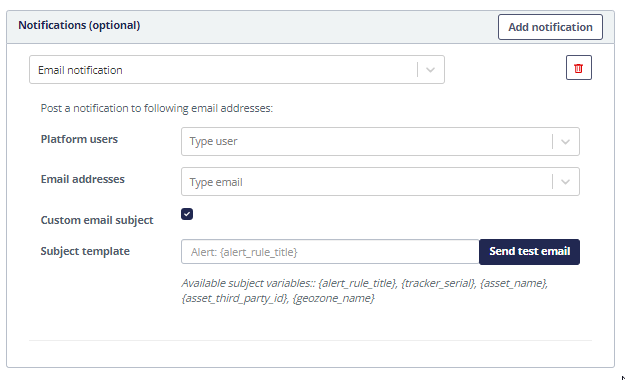Creating 'Asset stock too low' alerts
Create an alert to get notified when the number of assets in a geozone is too low during a certain time.
This task explains how to create a stock too low alert
Procedure
-
Go to Admin → Insights → Alert rules and select
 .
.
-
Enter a title (name) for the alert rule you create.
Note: The title is shown to all users receiving the alert notification and consulting the dashboard. Define clear and meaningful alert titles.
-
Write down a description of the alert rule (optional).
Note: Although optional, it is recommended to use the description to provide more information the end-users in order to ensure they understand the meaning of the alert rule.
-
Select the severity level of the alert. Some alerts are more severe then
others. You can choose between 'reminder', 'warning' and 'critical'.

-
Select the geozones for which you want to monitor the activity of your assets.
You can select these geozones by name, by geozone tag, or include all geozones.
In addition you should define the time period the asset should be in or out the
geozone for the alert to be given. Finally, you can choose which event types
trigger the alert. For example, you select STOP if you only want to alert to be
sent if the asset has stopped. You can select different event types if you
prefer.

- Minimum stock: Enter the minimum number of assets that should be available in the monitored zones.
- Select assets: Select what type of assets should be available. You can select these assets by identifier (name, serial,…), by tag or just select all of them at once.
- Select orientation state: Select if you want the orientation of the asset to be taken as an extra condition to be counted. You can choose between None (orientation is not taken as extra condition), Default (default defined orientation states, logically use of the tracker) or choose Custom setting (if you defined custom orientation states to your trackers).
-
Alert delay: Define how long the stock should be below the minimum stock
threshold before raising the alert by entering the number of days and hours.

-
Define the application time of the alert rule. Should it Always
monitor your assets on any day at any time or do you want it only to be
monitoring your assets on certain days? For the second option, select
‘Scheduled’. Here you can select on which days, during what hours. By
clicking the
 button you can
add more time periods. To exclude specific days, enable the Exclude specific
dates check-box and choose the dates on which the monitoring should be
disabled. Clicking the
button you can
add more time periods. To exclude specific days, enable the Exclude specific
dates check-box and choose the dates on which the monitoring should be
disabled. Clicking the  button
to add multiple exclusion dates. Additionally, you must define the time zone the
platform should use for evaluating the alert schedule. By default the time zone
of the current user is selected.
button
to add multiple exclusion dates. Additionally, you must define the time zone the
platform should use for evaluating the alert schedule. By default the time zone
of the current user is selected.
If you want to receive a notification when the alert is raised add an e-mail or REST notification
- By default, triggered alerts are only shown in the application. To enable the sending of notifications, click the Add notification button.
-
To enable Email notifications, choose 'Email notification' in the drop-down
list and complete the following fields:

Results
 button the inside geozone alert rule is created.
button the inside geozone alert rule is created. button.
button.